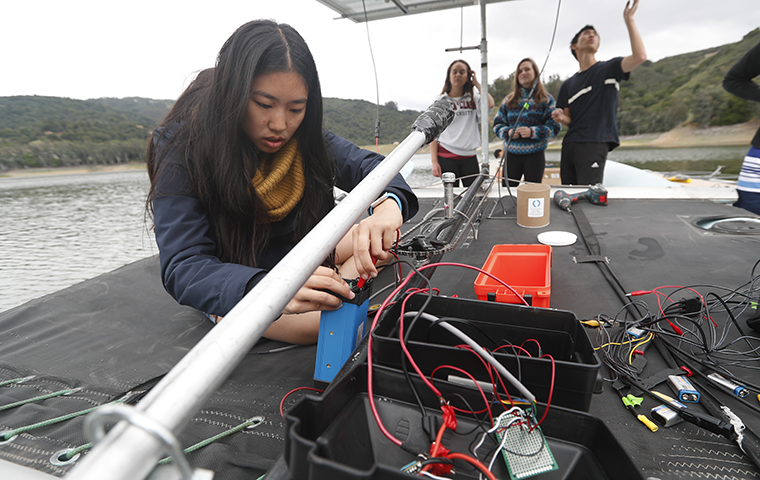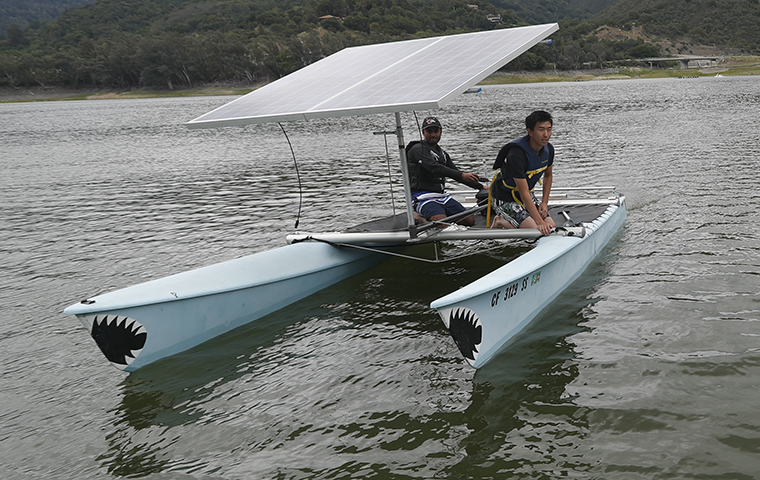
Find the Sun
Propelled by a revolving solar panel, a team of engineering students take fourth place in the SMUD Solar Regatta endurance race.
The wiring on the boat wasn’t perfect until Thursday night, just two days before the Sacramento Municipal Utility District Solar Regatta.
It was a design problem, essentially, Taylor Mau ’18 says. The wires that connected the solar panel to the motor of the Santa Clara University team’s solar-powered catamaran were tied together and adhered with electrical tape.
Technically, the tape worked fine. But when switching configurations of the boat Mau had to constantly retape and occasionally wiggle the wires to get the panels to connect to the converter.
“That’s not really user-friendly,” Mau says. “We didn’t want to do that.”
As an engineering major, Mau is interested in the user experience. Figuring out what customers need and engineering a solution. So in the last 48 hours before the competition, Mau found a connector online that would clip to the wire and make the connection process uniform. No more tying or taping or wiggling. Just a click. Success.
For engineering competitions like the SMUD Solar Regatta, this is the actual competition. Sure, there’s the regatta itself—the Santa Clara team finishing fourth in the endurance race May 5—but for these engineering competitions the design process is the competition. Making the right call on the hundreds of decisions that lead to a fourth-place finish.
Wanna build a solar powered boat?
The journey to Sacramento started in February 2017. Mau and James Wang ’19 were approached by Assistant Professor Maryam Khanbaghi with a simple question: Do you want to build a solar powered boat? Mau and Wang recruited teammates from programs all over campus: engineering, environmental science, chemistry, and physics.
The team consisted of Wang, Mau, Shivam Desa ’18, Naeem Turner-Bandele ’18, Shreyes Nallan ’20, Ansh Jetly ’21, Martin London ’21, Catherine van Blommestein ’19, Andrew Mitchelmore, Tai-Marcus Okuno ’19, Rosemary Cole ’19, Zach Steffen ’18, Eric Bressinger ’21, Brent Hosoume ’19, Peter Ferguson ’20, Mirazun Mitu ’21, Kristi Nguyen ’21, Jada Paddock ’20, Thomas Lyp ’21, Licheng Xiao ’23, Kevin Boehnlein ’18, Chelsea Villanueva ’20, Johann Espinosa ’20, and Thomas Heckman ’20.
SMUD provided solar panels, but from there, the design was up to them. The SCU team had to pick a boat, an engine, a converter, everything. Silicon Valley Power donated $2500 to their cause, helping fund the construction of their solar-powered boat.
During the fall, the team researched boat types—running models in a 3-D software program to see the benefits of each.
“Our main concern was the weight of the solar panels,” Wang says. “Each one was about 40 lbs. We also wanted to be able to support a person, of course, so we were mainly going for speed and stability.”
The team considered building their own boat before determining it was more cost effective to buy one. They settled on a catamaran.
“It has a deep-V hull, and it has two hulls,” Mau says. “So that way you don’t have ‘extra boat’ in the middle. It takes out that extra boat, and it's very stable.”

Once they had a boat, the team split into mechanical and electrical units. The mechanical side built the frame that held the solar panels, including a base that rotated 360 degrees to follow the sun, ensuring maximum energy. The rotating frame was controlled with a chain, gear, and cog.
Meanwhile, the electrical team was in charge of making sure the solar panel worked: picking a circuit to convert solar energy to motor energy. The solar panels themselves were 36 volts while the two motors the Santa Clara team purchased were 12 volts each.
Both Mau and Wang loved the real-world implementation and challenges of the project. The team spent the final weeks of the competition just troubleshooting. Swapping out pipes. Soldering things. Reducing drag as much as possible.
Perhaps the best lesson was when they looked back at what they made and what they might’ve done differently. For example, their boat was much bigger than other schools—17 feet by 8 feet. The smallest boat at the competition was probably 4 ft by 2 ft, which could only hold one person.
Mau and Wang say the way their solar panels and motor are set up, their boat could make it to Hawaii. But for this competition, the races were just around a reservoir.
In the end, it’s about design thinking. For this competition, speed and maneuverability were the only factors to consider. In a different competition or designing a boat for production, being able to accommodate multiple would be more important.
Wang will return to SCU next year to finish up his undergraduate degrees in environmental science and electrical engineering. He was a Udall scholar this year. Mau is heading to graduate school at Carnegie Melon for the integrated innovation of products and services program.
“My background is in computer engineering, and electrical engineering. I’m very software/hardware, engineering base,” Mau says. “What I really want to do is get more into design so I can bridge the gap between engineering and design.”
As for the Solar Regatta, SCU will be back next year. “Team members have been talking about having this be a reoccurring event,” Wang says. “We probably won’t start a club based around it, but we’ll at least have people work on it. We can learn from this year.”
Taylor Mau ’18 adjusts the wiring in the SCU solar-powered catamaran.